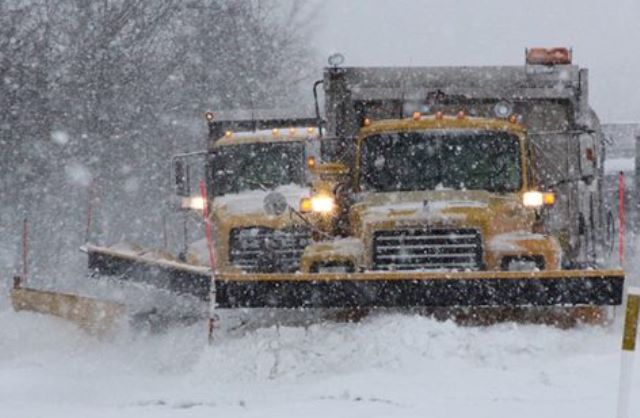HARRISBURG -Ahead of winter weather expected across most of the state tomorrow, the Pennsylvania Department of Transportation (PennDOT) is planning to implement vehicle restrictions on several Pennsylvania roadways starting at 5 a.m. Saturday.
Additionally, PennDOT advises motorists to avoid unnecessary travel in affected areas during the storm.
Restrictions will be communicated via variable message boards, the 511PA traveler information Web site and smartphone apps. Motorists can also sign up for personalized alerts on the Web site.
Effective at 5 a.m. on Saturday, March 12, vehicle restrictions are planned for the following roadways at Tier 1 of the commonwealth’s weather event vehicle restriction plan:
- PA Turnpike I-76 (Mainline) from New Stanton (Exit 75) to Breezewood (Exit 161).
Effective at 5 a.m. on Saturday, March 12, vehicle restrictions are planned for the following roadways at Tier 3 of the commonwealth’s weather event vehicle restriction plan:
- Interstate 80 from I-79 to I-99; and
- The entire length of I-99.
Effective at 7 a.m. on Saturday March 12, vehicle restrictions are planned for the following roadways at Tier 1 of the commonwealth’s weather event vehicle restriction plan:
- I-81 from I-78 to I-80.
Effective at 7 a.m. on Saturday March 12, vehicle restrictions are planned for the following roadways at Tier 3 of the commonwealth’s weather event vehicle restriction plan:
- I-80 from I-99 to the New Jersey border;
- I-81 from I-80 to the New York border;
- The entire length of I-84;
- The entire length of I-180; and
- I-380.
Effective at 11 a.m. on Saturday, March 12 vehicle restrictions are planned for the following roadways at Tier 1 of the commonwealth’s weather event vehicle restriction plan:
- I-476 from I-78 to I-81.
Restrictions will remain in place until conditions have improved enough to warrant their removal. Additional speed restrictions and right-lane restrictions for commercial vehicles will be imposed as necessary on a regional level.
Under Tier 1 restrictions, the following vehicles are not permitted on affected roadways:
- Tractors without trailers;
- Tractors towing unloaded or lightly loaded enclosed trailers, open trailers or tank trailers;
- Tractors towing unloaded or lightly loaded tandem trailers;
- Enclosed cargo delivery trucks that meet the definition of a CMV;
- Passenger vehicles (cars, SUV’s, pickup trucks, etc.) towing trailers;
- Recreational vehicles/motorhomes;
- School buses, commercial buses and motor coaches not carrying chains or Alternate Traction Devices (ATD’s); and
- Motorcycles.
On roadways with Tier 3 restrictions in place, no commercial vehicles are permitted except loaded single trailers with chains or approved Alternate Traction Devices.
Additionally, all school buses, commercial buses, motor coaches, motorcycles, RVs/motorhomes and passenger vehicles (cars, SUVs, pickup trucks, etc.) towing trailers are not permitted on affected roadways while restrictions are in place.
PennDOT urges motorists to avoid travel if possible. If travel is necessary, use caution, reduce speeds and be aware of changing weather conditions.
To help make decisions regarding winter travel, motorists are encouraged to “Know Before You Go” by checking conditions on more than 40,000 roadway miles, including color-coded winter conditions on 2,900 miles, by visiting www.511PA.com.
511PA, which is free and available 24 hours a day, provides traffic delay warnings, weather forecasts, traffic speed information and access to more than 1,000 traffic cameras. Users can also see plow truck statuses and travel alerts along a specific route using the “Check My Route” tool.
511PA is also available through a smartphone application for iPhone and Android devices, by calling 5-1-1, or by following regional Twitter alerts.
Drivers should prepare or restock their emergency kits with items such as non-perishable food, water, first-aid supplies, warm clothes, a blanket, cell phone charger and a small snow shovel.
Motorists should tailor their kits to any specific needs that they or their families have such as baby supplies, extra medication and pet supplies.
When winter weather occurs, drivers should extra cautious around operating snow-removal equipment. When encountering a plow truck, drivers should:
- Stay at least six car lengths behind an operating plow truck and remember that the main plow is wider than the truck.
- Be alert since plow trucks generally travel much more slowly than other traffic.
- When a plow truck is traveling toward you, move as far away from the center of the road as is safely possible, and remember that snow can obscure the actual snow plow width.
- Never try to pass or get between several trucks plowing side by side in a “plow train.” The weight of the snow thrown from the plow can quickly cause smaller vehicles to lose control, creating a hazard for nearby vehicles.
- Never travel next to a plow truck since there are blind spots where the operator can’t see, and they can occasionally be moved sideways when hitting drifts or heavy snowpack.
- Keep your lights on to help the operator better see your vehicle. Also remember that under Pennsylvania state law, vehicle lights must be on every time a vehicle’s wipers are on due to inclement weather.
Last winter in Pennsylvania, preliminary data shows that there were 301 crashes resulting in four fatalities and 143 injuries on snowy, slushy or ice-covered roadways where aggressive driving behaviors such as speeding or making careless lane changes were factors.
For more information on safe winter travel, an emergency kit checklist and information on PennDOT’s winter operations including a video, visit www.PennDOT.gov/winter.
Additional winter driving and other highway safety information is available at www.PennDOT.gov/safety.
Follow the conversation by using #PAWinter on Twitter and like the department on Facebook and Instagram.



